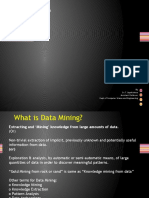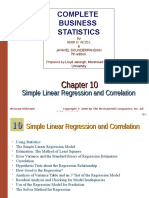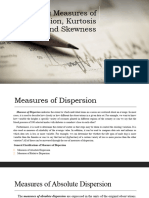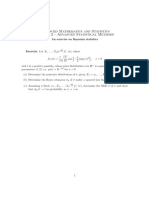DATA MINING
TECHNIQUES USING
R
� UNIT I: An idea on Data Warehouse, Data mining-KDD
versus data mining, Stages of the Data MiningProcess-
Task primitives., Data Mining Techniques – Data mining
knowledge representation.
�Data Warehouse
• Designed for storing and analyzing large volumes of historical data
from various sources for business intelligence and reporting
• Data Warehouse is a centralized & Organized respository of data
EXAMPLE
Amazon Redshift, Google BigQuery
��Data mining-KDD versus Data
mining
WHAT IS DATA MINING?
Data mining is the process of searching and analyzing a large batch of
raw data in order to identify patterns and extract useful information.
WHY DATA MINING?
• Discover Hidden Patterns
• Improve Decision-Making
• Enhance Customer Understanding
• Increase Efficiency
�Data mining-KDD versus Data mining
• While the terms are often used interchangeably, there is a subtle
difference. KDD is the entire process of uncovering useful information
from data, while data mining is just one step within that process.
�• Here’s a breakdown of the KDD process:
• Data Selection: Identify the relevant data for your project.
• Data Preprocessing: Clean and prepare the data for mining.
• Data Transformation: Transform the data into a format suitable for
mining algorithms.
• Data Mining: Apply algorithms to extract patterns and trends from
the data.
• Pattern Evaluation: Evaluate the validity and usefulness of the
discovered patterns.
• Knowledge Representation: Present the discovered knowledge in a
clear and understandable way.
��Stages of the Data MiningProcess-Task
primitives
1. Data Cleaning
Handling missing values, removing noise, correcting inconsistencies.
Example: In a customer database, some records might have missing age
values. These can be filled using the mean age or a default value.
2. Data Integration
Combining data from multiple sources.
Example: Integrating customer data from a CRM system with sales
data from an ERP system to create a comprehensive dataset for
analysis.
�3. Data Selection
Selecting relevant data for analysis.
Example: Selecting only the transaction records of the last two years
from a retail sales database to analyze recent purchasing trends.
4. Data Transformation
Normalization, aggregation, data type conversion.
Example: Normalizing the sales amount field to a common scale or
aggregating daily sales data to monthly sales data.
�5. Data Mining
Applying data mining techniques to extract patterns.
Example: Using the Apriori algorithm to find frequent itemsets in a
transactional database.
6. Pattern Evaluation
Identifying truly interesting patterns that represent knowledge.
Example: Evaluating association rules generated by the Apriori
algorithm to determine which ones have the highest confidence and
support values.
�7. Knowledge Presentation
Visualization, reporting.
Example: Creating a dashboard that shows the most frequent item
pairs purchased together and their association rules in a retail store.
�Task primitives:
Data mining task primitives are the essential components that guide the
data mining process. They provide a structured approach to extracting
meaningful insights from data.
Key Primitives
1.Set of Task-Relevant Data:
Defines the specific data used for the mining process.
Involves data selection, cleaning, and preprocessing.
Data: Customer information (demographics, subscription details, usage
patterns, billing history, etc.), churn data (customers who left the company).
Example: Selecting data for customers who have been with the company
for more than six months and have a monthly bill exceeding $50.
�2.Kind of Knowledge to be Mined:
• Specifies the type of patterns or information to be extracted.
• Common types include:
• Descriptive: Summarizing data characteristics (e.g., statistics, trends).
• Predictive: Building models to predict future values (e.g., classification,
regression).
• Associative: Discovering relationships between items (e.g., market basket
analysis).
• Cluster Analysis: Grouping similar data points (e.g., customer segmentation).
• Outlier Detection: Identifying unusual data points (e.g., fraud detection).
�• Background Knowledge:
• Incorporates domain expertise or prior information to guide the
mining process.
• Can improve accuracy and efficiency.
Domain expertise: Understanding of customer behavior, telecom
industry trends, competitor offerings.
Example: Incorporating information about recent network outages or
new competitor plans.
�4.Interestingness Measures and Thresholds:
• Evaluates the significance of discovered patterns.
• Helps filter out uninteresting or redundant patterns.
• Example: Support and confidence measures for association rules.
5.Representation for Visualizing Discovered Patterns:
• Determines how the mined patterns are presented.
• Includes charts, graphs, tables, decision trees, and other visual
formats.
• Example: Using a decision tree to visualize a classification model.
�Data mining techniques are methods used to discover patterns,
relationships, and insights from large sets of data.
Here are the main techniques used in data mining:
Classification: Sorting data into categories. For example, categorizing
emails as spam or not spam.
Clustering: Grouping similar items together. For example, grouping
customers with similar buying habits
Regression:Predicting a continuous value based on other variables.
Example: Predicting house prices based on factors like location, size,
and number of bedrooms
�• Association: Finding rules that show relationships between items. For
example, if people often buy bread and butter together.
• Prediction: Using past data to predict future outcomes. For example,
predicting which products will be popular next season.
• Sequential Patterns: Identifying patterns in data that occur in a
specific order. For example, finding that customers who buy a phone
often buy a case shortly after.
• Decision Trees: Using a tree-like model to make decisions based on
data. For example, deciding whether to approve a loan based on a set
of criteria.
�Data mining knowledge
representation.
In data mining, knowledge representation is crucial for effectively
interpreting, visualizing, and utilizing the insights and patterns derived
from data.
BAR GRAPH
�Histogram
�Pie chart
�Scatter plot
��Line chart
� LOESS curves
• LOESS (Locally Estimated Scatterplot Smoothing) is a non-parametric
regression method that is used to fit a smooth curve to a scatterplot
of data points
• LOESS curves are often used in real-world scenarios where data is
noisy and the relationship between variables is complex and non-
linear.






















































































